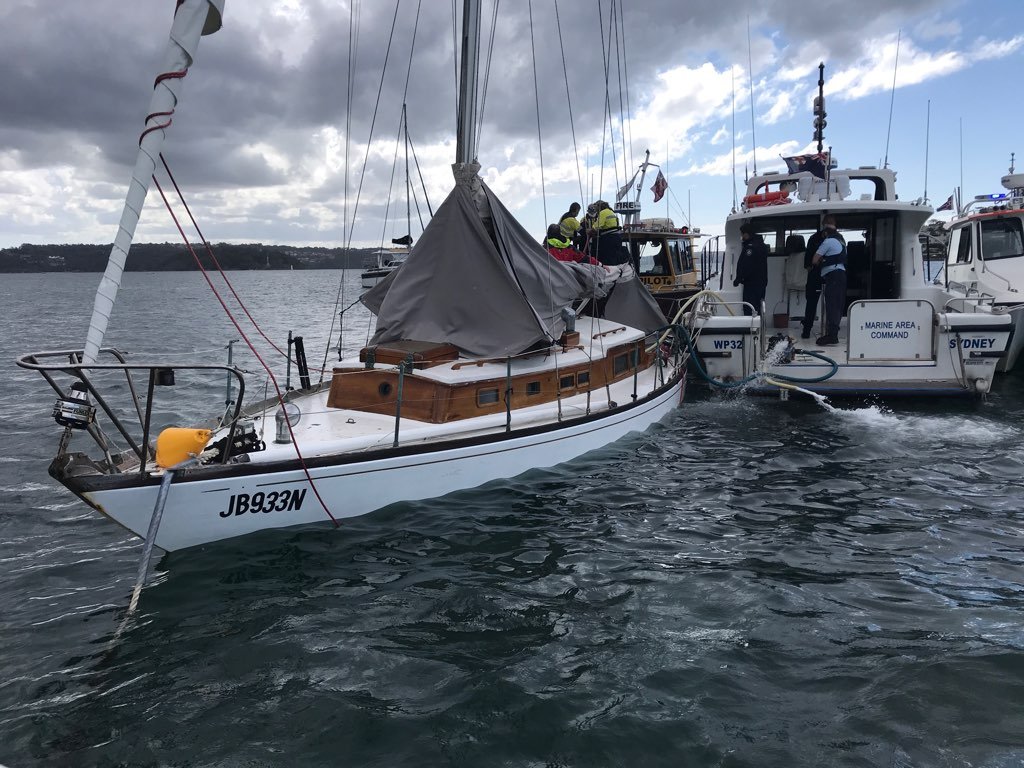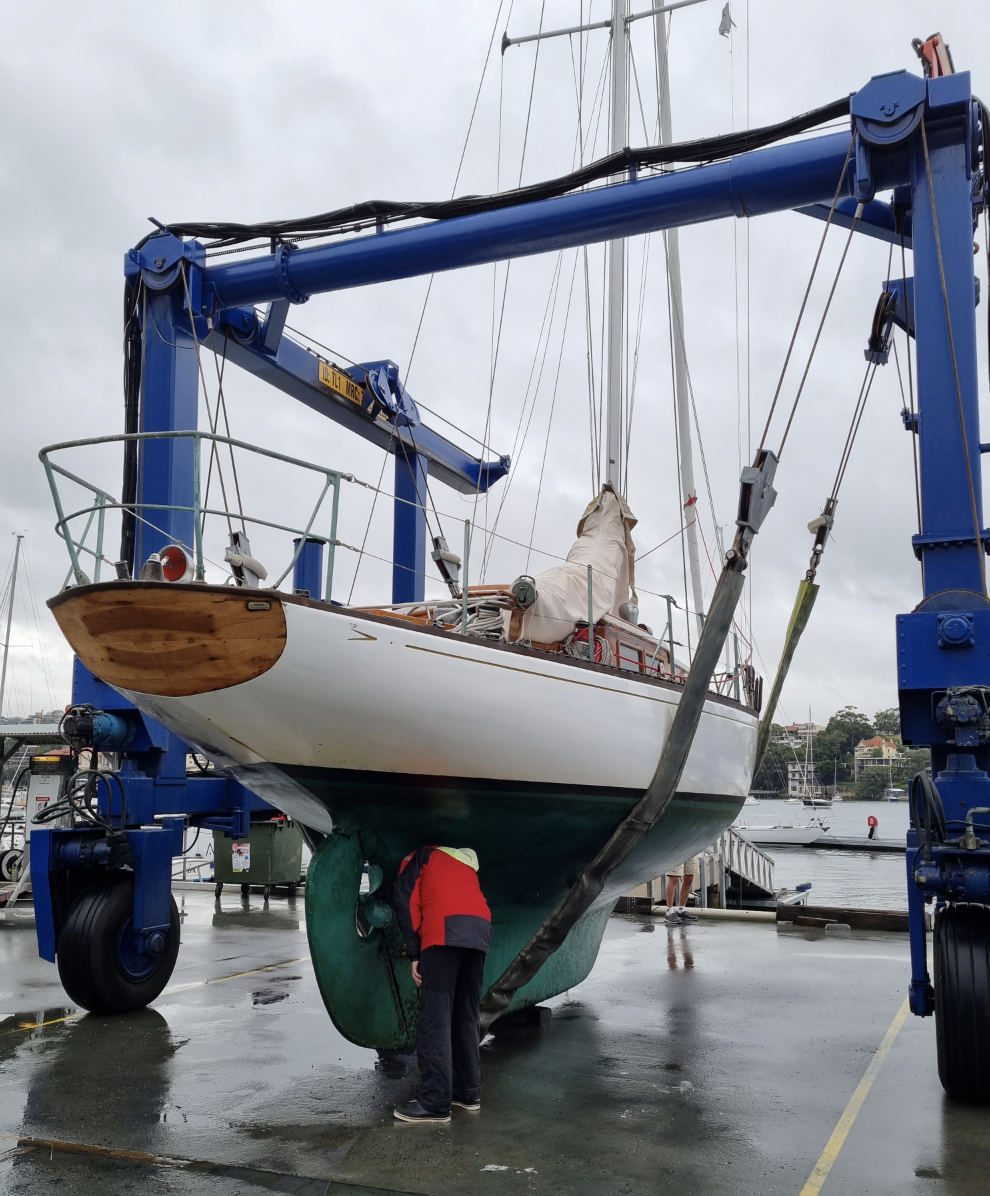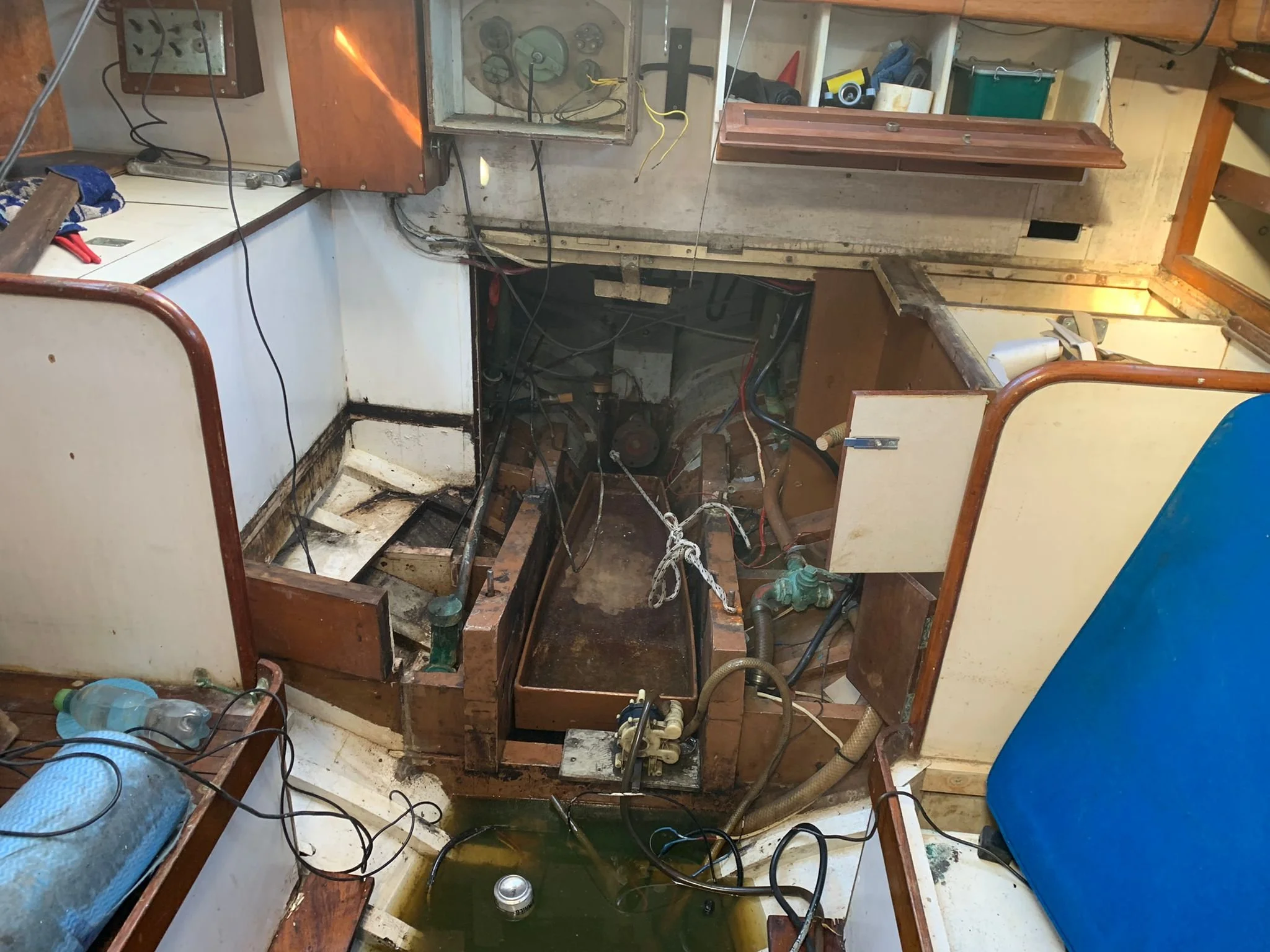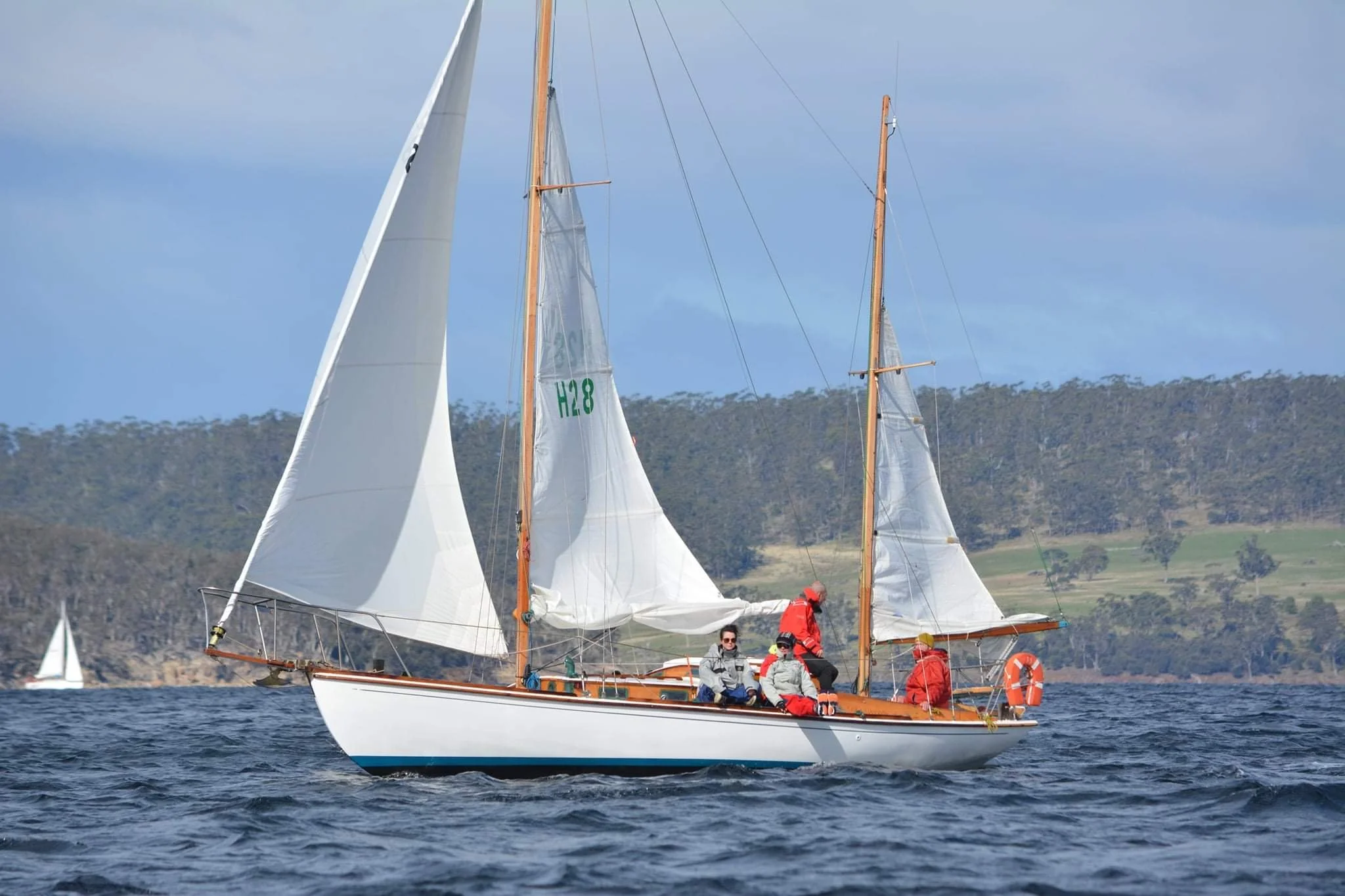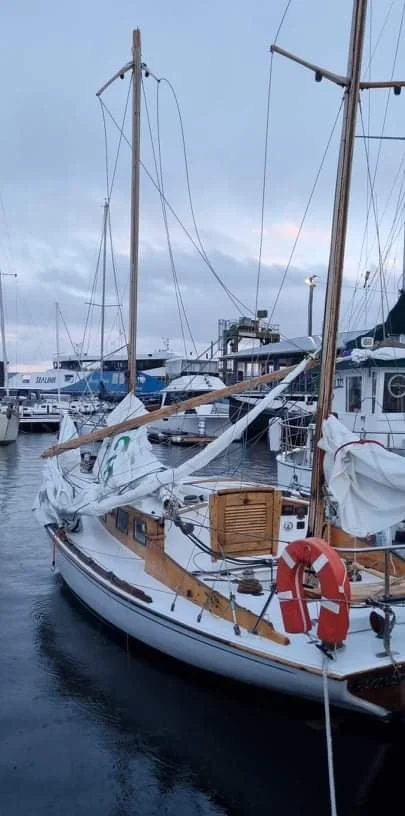That Sinking Feeling
By Chris Crerar
It was a call no boat owner wants to receive.
“Your boat has sunk”.
Greg from Flagstaff Marine, who’d led me through the purchase of MARCO POLO a few months back, was on the phone.
“You’re joking”, I reply, not registering with myself that a sinking joke has probably never been told by a marine broker.
“No, I’m not”, Greg says.
I feel myself go white just as Greg texts me an image of MARCO POLO still on its mooring but submerged almost down to the gunnels. Two NSW Marine Police boats and a Pilot are tied to her pumping out the unwelcome sea water. The sky in the photo is heavy and menacing, the sea almost black. It’s a photo I also never wished to receive.
“Who’d buy a boat interstate during the middle of a global pandemic”, I say to Greg, more than a little sarcastically.
The next few hours winds me into a ball of tension, speaking to the Marine Police, my insurers, and the insurance assessor as I’m hurled into the world of marine salvage and insurance claims.
My working week has just begun, and the day is already a write off.
Living in Tasmania, the pandemic was always happening somewhere else. Apart from an initial lock-down, sanitizing, checking in and getting vaccinated, we’d lived pretty normally. The worst effects of the Covid-19 pandemic were the stuff of news bulletins.
With Sydney deep into its recent lock-down, and no way to get to my stricken Marco Polo, I’d now brought the pandemic to me.
Lead me into temptation
I hadn’t intended to buy a boat interstate, but then came across MARCO POLO on Yachthub.
I’d been keeping my eye out for a classic mid-century timber sloop, of the Sparkman and Stephens, or Alan Buchanan variety, after falling for a gorgeous Alan Payne Tasman Seabird called SAFARI. Doug Jack sailed SAFARI with the Kettering Yacht Club and had sold her in the previous couple of years. For some reason, I didn’t quite believe I could own a boat like SAFARI when it was on the market.
A 1962 Cheoy Lee built Robb 35 in teak, MARCO POLO’s classic lines, timberwork, original fittings and roomy interior grabbed me when I first saw the listing. Already lovestruck, I jumped online the following morning to dream a little more and saw that the asking price had been reduced. I had to act now or miss out, I thought to myself.
I called the brokerage.
Greg said there had been a bit of interest in MARCO POLO, but nobody serious. MARCO was in good overall condition, but there was room for improvements, he said. “If I was to own a wooden boat, I’d be happy with this one”. I bet he says that all the time I thought to myself.
I was travelling to Sydney the following week to attend a mate’s book launch. Greg kindly offered to draw up a contract, with a refundable deposit and capacity to negotiate built in, to “quarantine” the boat.
After arriving in Sydney mid-afternoon, I went straight down to Rushcutters Bay. On one of those spectacularly luminescent late autumn days in Sydney, Greg had brought the boat into the CYCA ‘pond’ from its mooring in Double Bay. There were plenty of reasons why I could have walked away from MARCO POLO after my first inspection, however.
She was a bit rough in places, the old Perkins smoked like a steam train and was totally not set up for a big trip south. But what mattered was in good shape. Maintenance of the timberwork had obviously been a priority, increasing the project appeal to me. Combined with time warp originality, a huge cockpit, 6-foot-6 headroom, and a beautiful bum (counter-stern), I was drawn in and went ahead with the marine survey.
Marine surveyor Mark Humphrey produced a long list of, mostly minor, ‘to-dos’ but overall rated Marco Polo as sound, worthy of the effort required and priced well. A little negotiation followed, and a sale price agreed upon. I had just purchased a project boat 600 plus nautical miles from home in the middle of a global pandemic. What could possibly go wrong?
Back in May, the Delta variant hadn’t yet reached our shores and it looked like the worst of the pandemic was behind us. That my mate’s book launch was cancelled after contact tracing linked an employee of the publishers to the, now notorious, BBQ bloke case, might have been my first red flag. Beaming from my new purchase, I didn’t see it.
Fleet tragic
With a 1930s Tasmanian couta boat and a 1957 Herreshoff 28 to my name, I’ll happily be described as a wooden boat tragic. But definitely don’t want to be described as a tragic fleet owner.
After signing the sale contract, I hatched a plan to prepare my H28, MINERVA, for sale and make several trips to Sydney over winter and spring to prepare MARCO POLO for the trip home.
Then, a limo driver set Delta loose, and Sydney reluctantly ground into an inevitable lock-down. The Tasmanian Government shut our imaginary border with NSW, and I was effectively locked out, unable to visit MARCO POLO.
Weeks went by. MARCO’s previous owner had generously allowed me to continue using his mooring until some mechanical work was done and arrangements made for the boat to be moved to a new mooring at Careel Bay on Pittwater.
The old Perkins’ exhaust elbow was cactus and getting a replacement from overseas was going to take weeks apparently. Legendary Sydney diesel mechanic Ivan Tesic and I had just worked out that getting a replacement made up was the best option when I received that call.
And you’re so far away from me
Soon after being told the grim news by Greg, I’m put in touch with the insurance assessor, Gavin Clark. The boat has been refloated and a salvage crew is on the way to collect it from the mooring, he tells me.
They’ll take her out of the water and immediately begin cleaning and drying her out. I’ve never had a boat sink on me before but knowing there’s mostly solid teak timber downstairs in MARCO I try to reassure myself.
Over the next week, I oscillate between staying calm and trusting that MARCO is in good hands, and sheer blind panic that the insurance company may not pay out and I will have done all my dough. I call the Tasmanian Covid hotline, asking what I’d need to do on returning if I travelled to Sydney. I’m politely informed that I’m simply not permitted to enter Sydney currently, unless I’m an essential worker and, if I was able to travel there, I would need to undertake hotel quarantine upon returning at my expense.
I realise that my inability to travel to Sydney to see MARCO, and pitch in, is generating a below the surface tension in me. That kind of subconscious teeth grinding tension, where things concerning you are happening out of your control. “Breathe Chris, stay Zen Chris”, I continually tell myself.
Gavin is not 100% sure why MARCO sank but believes it was most likely that the drainpipe from the galley sink has become detached from the pipe coming up through the hull, and in the sloppy weather on the Sunday night it sank, it has turned into a syphon, filling the boat.
He says it’s a grey area (nice pun) in terms of insurance coverage. I feel my teeth grind down a touch harder.
I think to myself, there are three possibilities here. It’s either malicious intent, misfortune, or a cock up. The insurers won’t pay out if malicious intent can be proven, but they will for the other two. With me locked out and Sydney locked down, I reassure myself that the claim will most probably be approved.
By the end of the week, the old Perkins has been taken out in an attempt to save it. The electronics are gone, Gavin says, but he’s surprised at how well the interior has weathered the submerging. That would’ve been the end for many modern boats, he tells me.
Bad luck comes in threes
Needing some relief from sinking boats and insurance claims, I’ve entered MINERVA in the season opening Pipe Opener series hosted by the Derwent Sailing Squadron and the Kettering Yacht Club.
There’s a massive westerly blowing on the Saturday morning but, not wanting to be seen as fair-weather sailors, we get ready to head out.
“Well at least you’ve had your bad luck for the week”, says Suhela, our German-Bruny Islander crew member.
“Don’t say that”, I jokingly bark back, rolling my eyes.
“Doesn’t bad luck come in threes”, jokes Scott, our helmsman.
More eye rolling.
It’s a brutal race, but MINERVA is built for this. Every boat is reefed right down, including us. It’s freezing, there are horizontal downpours, howling gusts that must be approaching forty knots and the biggest chop we’ve experienced in the D’Entrecasteaux Channel. But we plug away, as H28s quietly do.
Then, an almighty bang. On a broad reach, heading towards Woodbridge, the main mast snaps. It breaks just above the spreaders and hangs suspended over the boats port side.
It instantly feels 10 degrees colder.
We’d lazily used the furling jib, rolled in about halfway, and it had clearly put too much pressure at the top of the mast.
As we limp back to the marina, like a dog with its tail between its legs, it occurs to me that I will most probably be dealing with two separate marine insurance claims now. Lucky the boats are insured through different companies, I think to myself.
Where’s my third instalment of bad luck, I hear you ask? About half an hour before the de-masting, the main boom smacked me to the deck in an uncontrolled jibe. Didn’t get my head luckily. I’m counting that. Three bouts of bad luck. That’s it, I’m clear now!
Escape plan
Gavin phones me on Monday. The insurer will cover the sinking claim, he says. I feel my shoulders lift a little and then, unexpectedly, my eyes well up.
I hadn’t realized how I’d been holding that layer of tension within me, not wanting to draw any conclusions before I genuinely knew the outcome.
As the engine couldn’t be saved, he outlines two options to me. Option one is an insurance repair, where a new engine and electronics are quoted up and the repairs done by those tradies. Option two sees the boat written off and, if I desire, I can buy it back at a salvage cost and have the work done by repairers of my choice. He says he’s getting quotes on replacement engines and electronics, but the cost of these may be close to my insured value, meaning that option two is potentially preferable for all.
I ask every young and old salt around Kettering for their opinion on which way to go and if they can point me in the direction of good shipwrights in Sydney. Everyone urges me to take the write-off option and get it out of the harbour!
Having a chat with the AWBF’s Rosco Barnett on-board his beautiful MAORI LASS, he confirms my thinking has been pointing in the right direction. Rosco suggests getting in touch with Mackenzie Marine’s Ian Begg up on Pittwater.
I’d followed Mackenzie Marine on Instagram for some time and had spoken to Ian months before the sinking about potential work on MARCO POLO. I’d been impressed with the focus of their work and Ian came across as a genuine bloke.
I phone Ian and explain the story. It’s getting longer to tell each time now, as so much has happened in the last 10 days. He says he wouldn’t take it on as an insurance repair, as “there are no winners on that route” but would be happy to work on MARCO otherwise.
He also says he might be able to organize to get MARCO out of the harbour and up to Pittwater.
It now feels like I have direction. The course is set.
After some negotiation back and forth between Gavin and I and Pickles, we settle on a buyback price of $10,000.
As the usual rigmarole of settling an insurance claim goes on, I find out that MARCO is not at Noakes, as I’d previously thought, but at a place called White Bay 6.
I also find out that after the boat is handed back to me, I’m paying $157 per day to have Marco on the hard there. That’s about four times what the cost per day is at the Oyster Cove Marina in Kettering.
Sydney friends were right about boat ownership on the harbour being for the rare and privileged few.
Knowing this, I’m now extra keen to get MARCO back in the water and up to Pittwater. A launch date is set for the following Monday. Local shipwrights go over all the through hull valves, making sure she won’t sink again once back in the drink.
Ian isn’t happy with a Monday launch though. There’s a south easterly trough forecast for that week off Sydney, and it totally won’t be the weather for towing an engineless boat outside the heads and up to Pittwater.
Sunday will be a narrow window of fine weather, before the trough hits. Ian can get himself and his tow bloke there, if we can get Marco launched on the Friday, with 24 hours in the water to allow the timbers to take back up.
What ensues next is an infuriating lesson in corporate inflexibility and how an old wooden boat like Marco Polo really is a burden rather than a priority to a business like White Bay 6.
Despite all the charm I can muster and logical and rational arguments about the coming week of foul weather, White Bay 6 will not allow Marco to be tied up to one of their ‘wet berths’ for even 24 hours on a weekend.
The weekend is for dry storage customers only.
I google map the place and it seems to have plenty of pier space. I enlist Greg at Flagstaff to have a chat as he knows them well. He phones back saying, “well, I obviously don’t have the sway I thought I had”. Ian speaks to them. We try and we try.
Exasperated, we give up and stick with the Monday launch.
MARCO is launched and doesn’t sink. In fact, the planking takes up really well, I’m told.
MARCO is tied up to the White Bay 6 piers for another 3 days – at $100 per day – before Ian can get her towed to a mooring in Middle Harbour, from where he and his mate with ‘The truck’ would collect her the coming Sunday.
I decide all of this is almost like an out of body experience, as I’m so used to being involved with the movements of my boats.
Early that Sunday morning – as MARCO is about to be towed north - I send Ian a text wishing him good luck and a tell him to take plenty of photos.
Moments later, my phone pings as a text from Ian fires back.
“Just off long reef”, it says, accompanied by a dodgy looking pic of MARCO’s cockpit, Ian’s feet, the blue of the ocean and an even bluer sky. And I feel all the weight of the past fortnight lift from my shoulders, as I know the saga is finally ending and MARCO POLO will now be safe on a mooring just off Mackenzie Marine.
If crystal balls existed, I probably wouldn’t have bought a project boat interstate during the middle of a global pandemic but, as all my friends remind me, I wasn’t to know the Delta outbreak would hit Sydney so hard.
But I do know now that this an era of uncertainty, and we really can’t predict what is around the corner.
Hopefully, I’ll get to spend some weeks over summer on Pittwater, working with Ian and his team, repairing Marco and preparing her for the big trip south.
But who knows, right?!

